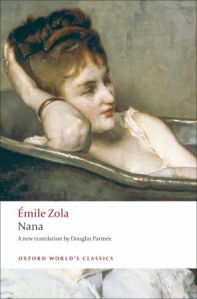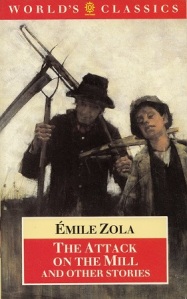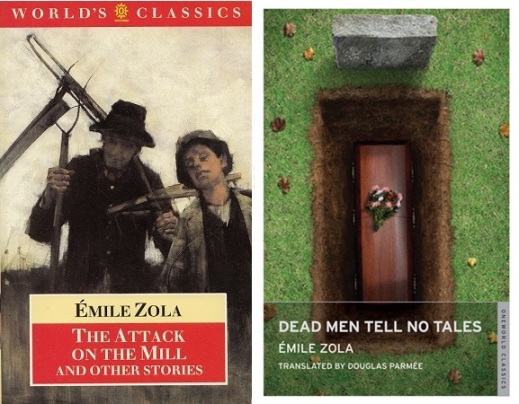 Nana (1880) is one of Zola’s many masterpieces in the Rougon-Macquart cycle, no.17 in the recommended reading order. It follows the spectacular career of the young girl who ran wild at the end of L’Assommoir (1877) (see my review) and was last seen beginning her life as a prostitute, entering high society in a grand carriage as her alcoholic mother dies pathetically in abject poverty.
Nana (1880) is one of Zola’s many masterpieces in the Rougon-Macquart cycle, no.17 in the recommended reading order. It follows the spectacular career of the young girl who ran wild at the end of L’Assommoir (1877) (see my review) and was last seen beginning her life as a prostitute, entering high society in a grand carriage as her alcoholic mother dies pathetically in abject poverty.
In Nana she starts out as a showgirl of very little talent in a (fictional) opera called La blonde Vénus at the Théâtre des Variétés, but her beauty makes her the talk of the town. From the moment she flaunts her gorgeous body on stage, the audience is agog, and the men who fancy her almost batter down the stage door to gain access to her dressing-room. While she’s not a cunning woman, and she all too often acts against her own best interests, she soon realises that what she needs is a wealthy patron who can set her up in style, and she finds a helpful servant called Zoé to manage the queues so that they don’t bump into each other.
BEWARE: SPOILERS
This ‘good-time-girl’ symbolising the moral corruption of the Second Empire destroys every man who comes her way, and most often their families too. Her insatiable appetite for extravagance and her inability to manage money even when she’s got a lot of it, means that she expects to be paid lavishly for her charm, and she bankrupts one man after another. Her first major victim is Steiner, who buys her a lovely house in the country and is thrown over as soon as he bankrupts himself with speculations on the stock exchange…
That idyll in the Loire also brings her into contact with young, naïve Georges Hugon. He comes from a very respectable old family and his widowed mother is mortified by the sudden presence of Nana and her disreputable friends in her region, but Georges loses his innocence in no time, and so does his brother Philippe who was subsequently despatched to rescue him. Both of these young men come to a terrible end, leaving Madame Hugon devastated.
Zola paints the indifference of society to the financial carnage with a mocking pen, but he does not spare his readers an insight into more catastrophic consequences. Vandeuvres has a vast fortune from inheritance which he was busy wasting even before he met Nana. But by the time Nana has finished with him, his only recourse to recover what he has lost is to gamble vast amounts at the racecourse. The scandal that ensues after he gets involved in a betting scam sends him to despair, but society moves on.
And so does Nana. Her most spectacular victim is Count Muffat, a pious and respectable man of old family who loses his head over her and ends up in ruin. He’s a foolish man, but it’s hard not to feel a little pity for him when he realises that he’s spent his fortune buying Nana’s fidelity to him, but has never had it. Her mansion in the heart of Paris is, with its red walls and suffocating heat is a holocaust consuming the honour of the whole of [his] ancient house, and in a superb irony, Muffat’s own wife duplicates the décor in his own home as she, too, descends into debauchery. In a magnificent set scene at his daughter’s extravagant engagement party, Muffat is forced to shake the hand of his rival and Nana’s lover Fouchery to the strains of The Blonde Venus waltz. Everyone there is aware of Nana’s presence although she is not there in person: she is responsible for the décor, for the music, for Muffat’s choice of future son-in-law and for his forced reconciliation with his wife.
Muffat, long tortured by the qualms of his Catholic conscience, finally recognises his degradation when he stumbles in on his own father-in-law in bed with Nana. It is from this point on that Zola starts to chart the downfall of all of Nana’s men, and finally, of Nana herself, exhausted by her own inexhaustible folly and greed, and succumbing at the last, to the corruption of smallpox. Her death is so horrible and so noxious that none but her old rival Rose will care for her; her men stand vigil outside her hotel window, but they are talking of politics, not of love.
It is a pathetic end for a girl who, in the Loire Valley, dreamed of achieving respectability like old Irma d’Anglars, a former Parisian prostitute who lives in a grand chateau bought by a former lover and has reinvented herself as a pious old lady. Nana had been enchanted by country life, and was ecstatic that her small child could live with her there. Alas, that idyll among the plants blooming in the rain was interrupted by the arrival of young Georges, and before long her men had followed her from Paris, bringing their sordid demands with them.
She tries family life too, in an impetuous marriage to Fontan. She sells off her trinkets and abandons her creditors to try life in Montmartre but that soon sours too. In a rare example of Zola’s writing making me feel very uneasy, there are disturbing scenes of domestic violence. As you’d expect in this author’s realism, there have been examples of this in his other novels too, but this is the first in which he writes that the abuse makes her more attractive:
But after that evening, their life together grew increasingly stormy. From one week’s end to the next, there was a constant sound of slaps, regulating their lives like the ticking of a clock. Nana got so many thrashings that she became as soft as fine linen, her skin delicate, her complexion pure peaches-and-cream, so tender to the touch and so radiant that she looked even lovelier. (p.231)
I can’t imagine what made him write that, I really can’t.
What is more authentic is that, like many victims of domestic violence, Nana blames herself, and goes to great lengths to please and placate a man who uses any excuse at fault-finding to beat her. And as is so often the case, those who witness it do nothing – and even Madame Lerat’s advice to leave him is motivated by wanting Nana to return to earning money. Her submissiveness is in marked contrast to her usual high-handed behaviour, and she ends up having to go back to street work because he won’t give her any money. It is only when he throws her out, that she finally escapes from this situation*.
Unlike most of the characters in this novel, Nana is a complex character. (Even Muffat is a bit of a parody). In some ways she is incredibly naïve, and her hot temper leads her into all sorts of difficulties. She wants to be well-off and respectable, but because she is so improvident, she throws her chances away, first with Steiner and then with Muffat. She thrives on her celebrity status, exulting in the cheers of the crowd at the race course when they cheer the winning horse with her name. She is scatter-brained, quixotic, and extravagant in manner as well as with money, and she takes a perverse pride in ruining her lovers. But although there is a lesbian affair between her and young Satin, and although she often derides men, Nana often enjoys their company as friends and regards the sexual act as an act of friendship. (Except for the marriage with Fontan), she is a woman who has agency over her own body and her own career but not in a way that Zola approves. She is a symbol of French corruption under the Second Empire, and her characterisation has to serve that.
The settings of the novel allow for the juxtaposition of the ‘old’ Paris with the new, showing each time how the vulgar and the brash intrude into polite society. In grand old houses, in the countryside, at the theatre and at the races, the men straddle both worlds, bringing moral decay with them. Noticeably, there are no young people offering redemption, only the elderly helplessly deploring the situation. Even Estelle, the plain young girl who is married off to Nana’s old lover Daguenet, is judged incapable of reforming him, she’s completely insignificant. And as the novel ends with the declaration of war against Bismarck, even the saucy ladies who came to view Nana’s grotesque body are making plans to save what they can from the coming disaster.
As always with this series of Oxford World’s Classic, the artwork on the cover is an aptly chosen painting. This one is a detail from ‘The Bath’ by Alfred George Stevens in the Musée d’Orsay, but the image has been reversed.
Author: Émile Zola
Title: Nana
Translated from the French by Douglas Parmée
Publisher: Oxford World’s Classics, 2009
ISBN: 9780199538690
Review copy courtesy of Oxford University Press.

(I also have the illustrated 1956 Folio edition of Nana, but I chose to read this edition because it has a good introduction and a more recent translation. But the etchings by Vertes in the Folio edition are gorgeous!)
*If you or someone you know is impacted by sexual assault, domestic or family violence, call 1800RESPECT on 1800 737 732 or visit 1800RESPECT.org.au. In an emergency, call 000. For more information about a service in your state or local area download the DAISY App in the App Store or Google Play.
Availability
Fishpond: Nana (Oxford World’s Classics)
Cross-posted at ANZ LitLovers

